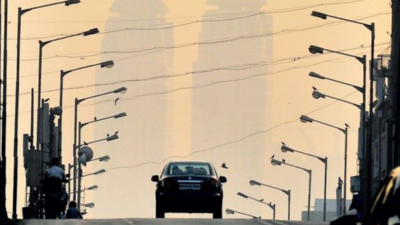Top Searches
- News
- City News
- mumbai News
- State of air quality in Maharashtra: It may soon be harder to breathe
State of air quality in Maharashtra: It may soon be harder to breathe

Threshold for aerosol pollution vulnerability is considered to be an AOD value of 0.4. Regions (states in the current context) that are above this threshold are considered vulnerable
MUMBAI: The state is likely to enter the 'highly vulnerable' territory on aerosol pollution next year from the current 'vulnerable'. This may not only lead to a drop in urban visibility, impacting vehicular and air traffic, but, more worryingly, threaten the health and wellbeing of people, especially in urban areas. The findings are of a study by Kolkata researchers that has been published in the prestigious Atmospheric Environment Journal, brought out by academic publishers Elsevier.

High aerosol amounts include particulate matter (PM2.5 and PM10, considered carcinogenic) consisting of sea salt, dust, sulphate, and black and organic carbon (see graphic for details). If inhaled, they can be extremely harmful to health. Among the many solutions, top is the curbing of thermal power plants, emissions from which result in toxic aerosols in air, says the study 'A deep insight into state-level aerosol pollution in India' by Dr Abhijit Chatterjee, associate professor of environmental sciences, Bose Institute, and PhD scholar Monami Dutta.
Track the pollution level in your city
The study provides a national scenario of aerosol pollution with a long-term trend (from 2005 to 2019) and future scenario (2023) for India's states. The main parameter the study mentions is called aerosol optical depth (AOD), a quantitative estimate of aerosols present in the atmosphere, which can be used as a proxy measurement of PM2.5. right now, Maharashtra is under the 'orange category' (see graphic for explanation) which is a vulnerable zone with an AOD of 0.4-0.5. But rising aerosol pollution - air pollution - is expected to push AOD beyond 0.5, thus making the state enter the most vulnerable zone (red).
The values of AOD range from 0 and 1, with 0 indicating a crystal-clear sky with maximum visibility and 1 indicating very hazy conditions.
According to the study, air pollution in Maharashtra has mostly been caused by coal-based thermal power plants (TPP) - emissions increased from 31% to 39% from 2005 to 2019
But capacity is increasing with an increase in the demand for electricity. "If the state continues to install TPP capacity as observed in the past... it could result in an increase in morbidity rates, decrease in life expectancy, along with other health issues, for the people of Maharashtra. The state can witness a 7% rise in AOD from 2019 to 2023," said Chatterjee.
"In order to control such threats, the state government should... focus on reducing the current TPP capacity by at least 10GW (41%)," said Dutta, a senior research fellow at Bose Institute, whose name is listed first on the study.

High aerosol amounts include particulate matter (PM2.5 and PM10, considered carcinogenic) consisting of sea salt, dust, sulphate, and black and organic carbon (see graphic for details). If inhaled, they can be extremely harmful to health. Among the many solutions, top is the curbing of thermal power plants, emissions from which result in toxic aerosols in air, says the study 'A deep insight into state-level aerosol pollution in India' by Dr Abhijit Chatterjee, associate professor of environmental sciences, Bose Institute, and PhD scholar Monami Dutta.
Track the pollution level in your city
The study provides a national scenario of aerosol pollution with a long-term trend (from 2005 to 2019) and future scenario (2023) for India's states. The main parameter the study mentions is called aerosol optical depth (AOD), a quantitative estimate of aerosols present in the atmosphere, which can be used as a proxy measurement of PM2.5. right now, Maharashtra is under the 'orange category' (see graphic for explanation) which is a vulnerable zone with an AOD of 0.4-0.5. But rising aerosol pollution - air pollution - is expected to push AOD beyond 0.5, thus making the state enter the most vulnerable zone (red).
The values of AOD range from 0 and 1, with 0 indicating a crystal-clear sky with maximum visibility and 1 indicating very hazy conditions.
According to the study, air pollution in Maharashtra has mostly been caused by coal-based thermal power plants (TPP) - emissions increased from 31% to 39% from 2005 to 2019
But capacity is increasing with an increase in the demand for electricity. "If the state continues to install TPP capacity as observed in the past... it could result in an increase in morbidity rates, decrease in life expectancy, along with other health issues, for the people of Maharashtra. The state can witness a 7% rise in AOD from 2019 to 2023," said Chatterjee.
"In order to control such threats, the state government should... focus on reducing the current TPP capacity by at least 10GW (41%)," said Dutta, a senior research fellow at Bose Institute, whose name is listed first on the study.
FOLLOW US ON SOCIAL MEDIA
FacebookTwitterInstagramKOO APPYOUTUBE
Start a Conversation
end of article









